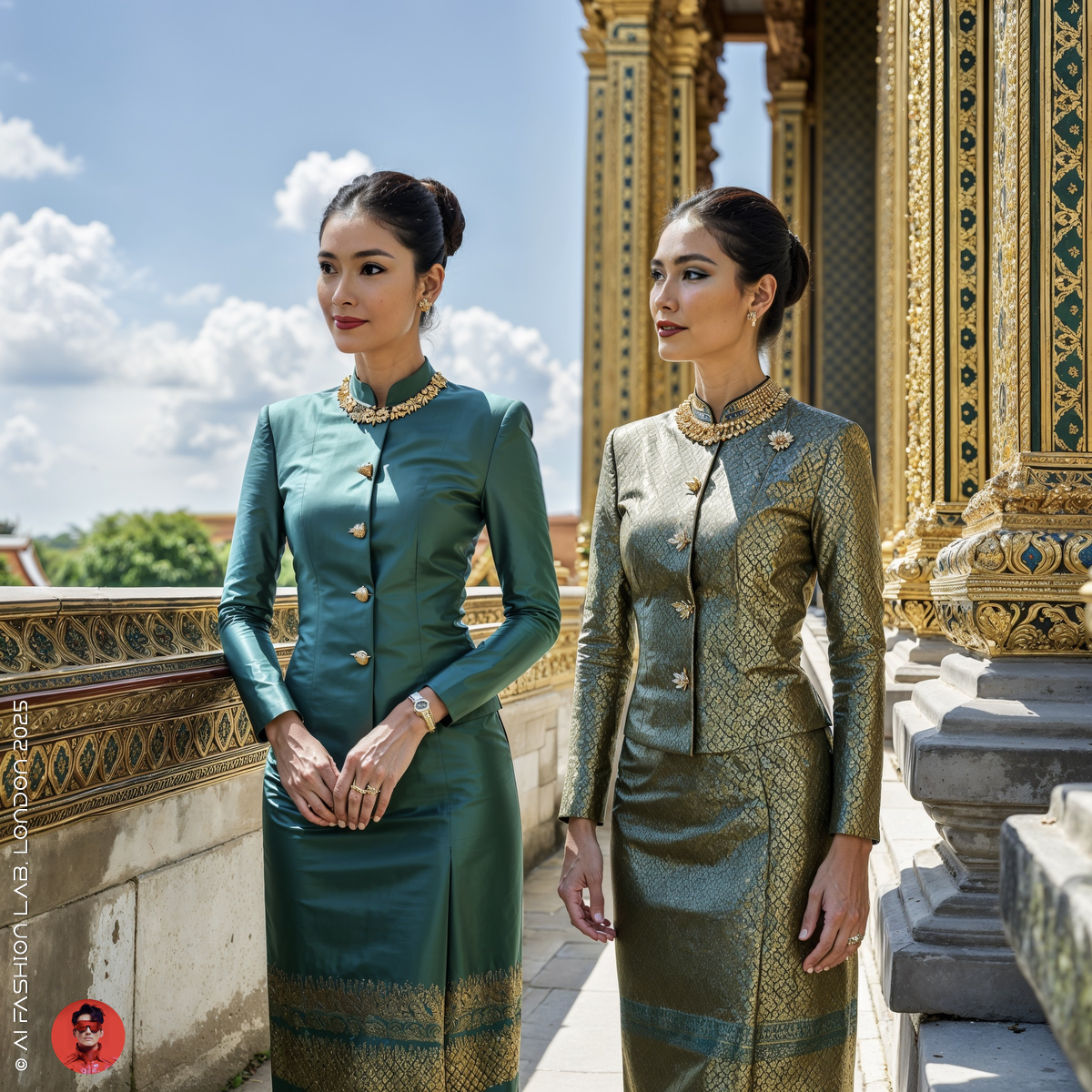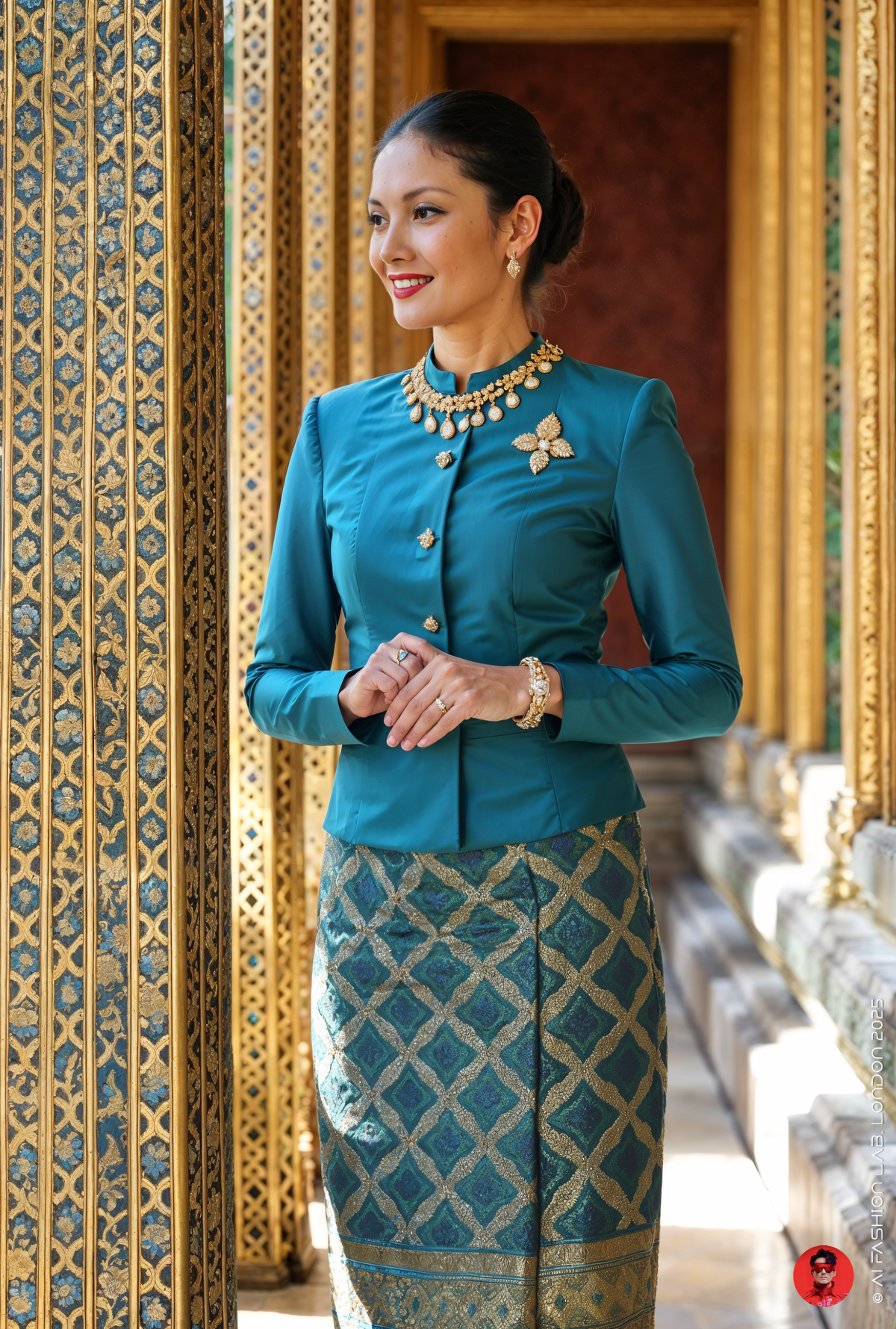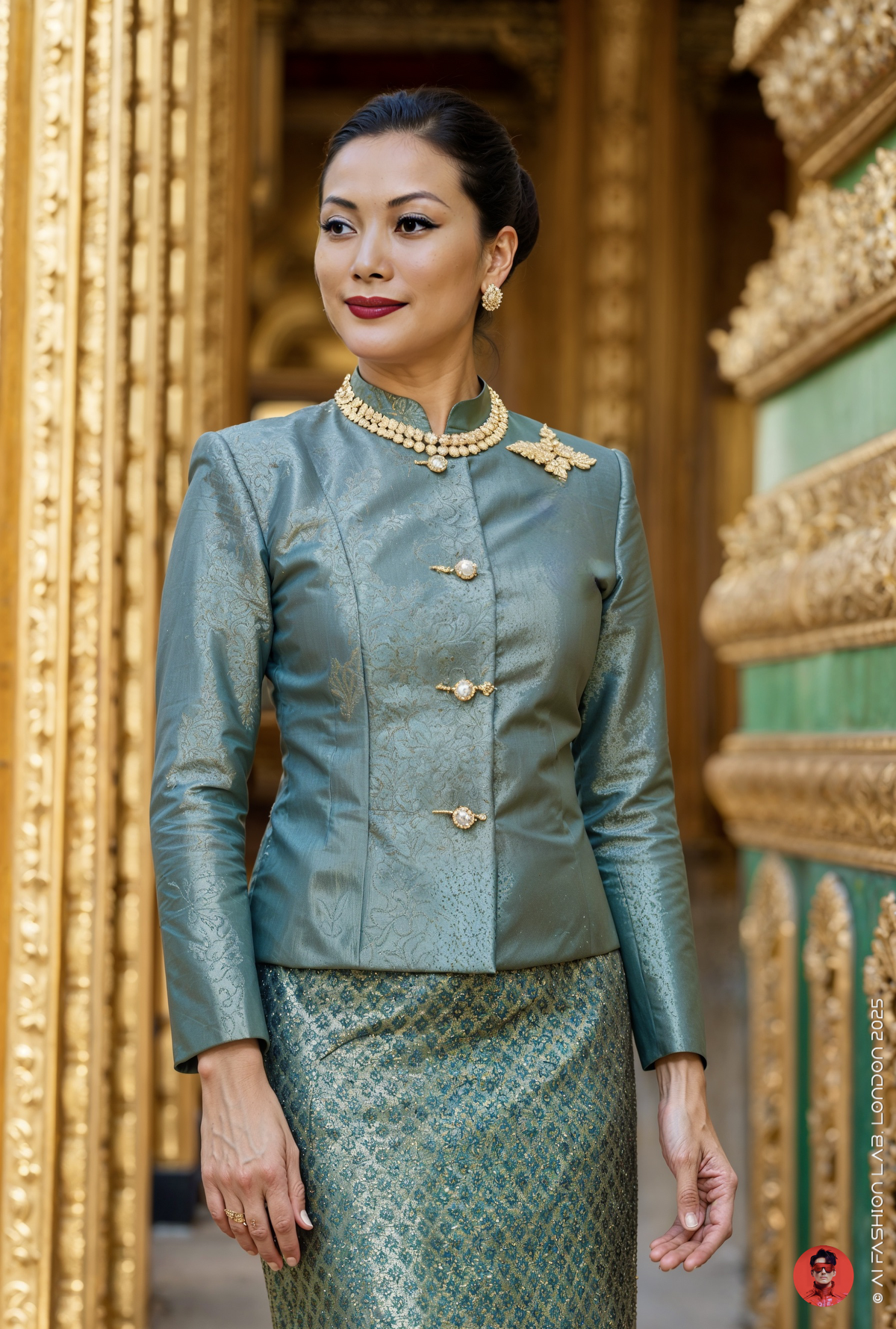ชุดไทยจิตรลดา ชุดไทยพระราชนิยม – เครื่องแต่งกายประจำชาติและความภาคภูมิใจในความเป็นไทย (ชุดแบบที่ 2 จากทั้งหมด 8 แบบในชุดไทยพระราชนิยม) (ตอนที่ 2)
ชุดไทยจิตรลดา ชุดไทยพระราชนิยม – เครื่องแต่งกายประจำชาติและความภาคภูมิใจในความเป็นไทย (ชุดแบบที่ 2 จากทั้งหมด 8 แบบในชุดไทยพระราชนิยม) (ตอนที่ 2)
AI Collection ในซีรีส์ ชุดไทยพระราชนิยม ชุดนี้ ได้รับแรงบันดาลใจจาก สมเด็จพระนางเจ้าสิริกิติ์ พระบรมราชินีนาถ พระบรมราชชนนีพันปีหลวง และชุดไทยพระราชนิยมทั้ง 8 แบบ ซึ่งทรงมีพระราชดำริจัดสร้างขึ้นระหว่างปี พ.ศ. ๒๕๐๓-๒๕๐๔ เพื่อให้สตรีไทยมีเครื่องแต่งกายที่สง่างาม สะท้อนเอกลักษณ์ของความเป็นไทย และเหมาะสมกับงานพิธีและโอกาสสำคัญต่าง ๆ
ชุดไทยจิตรลดา นับเป็นชุดแบบที่ 2 ในบรรดาชุดไทยพระราชนิยมทั้ง 8 แบบ ออกแบบมาเพื่อสวมใส่ในงานพิธีช่วงเวลากลางวัน มีลักษณะสุภาพ เรียบหรู และแฝงไว้ด้วยความเป็นทางการ ตัวเสื้อทำจากผ้าไหมแขนยาว คอตั้งเล็กน้อยในแบบคอจีน เพื่อเสริมภาพลักษณ์อันสง่างามและเป็นทางการ แตกต่างจากชุดไทยเรือนต้นที่ใช้คอกลมต่ำและเหมาะกับโอกาสลำลอง
เสื้อทรงจิตรลดานี้นิยมสวมคู่กับ ผ้าซิ่นยาวคลุมข้อเท้า ซึ่งมักทอด้วยเทคนิค “ยกเชิง” โดยอาจเลือกใช้ผ้าพื้นสีเดียวกัน หรือผ้าต่างสีก็ได้ตามความเหมาะสม ชุดนี้เหมาะสำหรับพระราชพิธี หรือการต้อนรับอาคันตุกะจากต่างประเทศอย่างเป็นทางการ โดยไม่มีการประดับเครื่องราชอิสริยาภรณ์หรือเหรียญตราใด ๆ ดังเช่นในชุดไทยอัมรินทร์
แรงบันดาลใจจากขนยูงและแฟชั่นวินเทจ
สำหรับคอลเลกชันแฟชั่น ชุดไทยจิตรลดาที่สร้างสรรค์ด้วย AI ชุดนี้ ได้รับแรงบันดาลใจจากความงดงามของขนยูงไทย ซึ่งเปรียบเสมือนสัญลักษณ์แห่งความสง่างามและความมีศักดิ์ศรีในวัฒนธรรมเอเชียตะวันออกเฉียงใต้ โดยเฉพาะในบริบทของสังคมไทย ขนนกยูงมีลวดลายแวววาวที่สะท้อนแสงได้หลากสีสัน
ผมจึงเลือกนำโทนสีหลักจากขนยูงมาถ่ายทอดลงในงานออกแบบแฟชั่นชุดไทยจิตรลดาในคอลเลกชันนี้ ซึ่งประกอบด้วย สีเขียวหยก (jade green), สีฟ้าเทอร์ควอยซ์ (turquoise), สีน้ำเงินอุลตร้ามารีน (ultramarine), และสีน้ำเงินเข้มอมม่วงแบบลาพิสลาซูลี (lapis lazuli) โทนสีเหล่านี้สะท้อนถึงความสงบ ความมั่นคง และความสง่างาม ทั้งยังชวนให้นึกถึงเสื้อผ้าไหมแบบชาววังในอดีต
คอลเลกชันนี้ยังผสานกลิ่นอายของแฟชั่นวินเทจยุค 1960s ซึ่งเป็นยุคที่ชุดไทยพระราชนิยมถือกำเนิดขึ้นครั้งแรกในรัชสมัยของสมเด็จพระนางเจ้าสิริกิติ์ พระบรมราชินีนาถ โดยมีเป้าหมายเพื่อกำหนดรูปแบบชุดประจำชาติของสตรีไทยในเวทีระหว่างประเทศ
ด้วยเทคโนโลยี AI ผมสามารถสร้างสรรค์ภาพแฟชั่นที่สะท้อนความงดงามของชุดไทยจิตรลดาในยุคปัจจุบัน โดยยังคงไว้ซึ่งโครงสร้างดั้งเดิม อันเป็นการสื่อสารอัตลักษณ์ไทยผ่านเทคโนโลยีสมัยใหม่ในศตวรรษที่ 21 การใช้ AI ในที่นี้จึงไม่ใช่เพียงการสร้างภาพแฟชั่น หากแต่เป็นการ อนุรักษ์ ถ่ายทอด และเฉลิมฉลองมรดกวัฒนธรรมไทยในรูปแบบร่วมสมัย
พระราชนิยมในการใช้ผ้าไทย: พระปณิธานของสมเด็จพระนางเจ้าฯ พระบรมราชินีนาถ
ในปี พ.ศ. ๒๕๐๓ (ค.ศ. 1960) สมเด็จพระนางเจ้าสิริกิติ์ พระบรมราชินีนาถ พร้อมทั้งพระบาทสมเด็จพระเจ้าอยู่หัวภูมิพลอดุลยเดชมหาราช รัชกาลที่ ๙ เสด็จพระราชดำเนินไปยัง ๑๔ ประเทศในทวีปยุโรปและอเมริกา เพื่อทรงเจริญสัมพันธไมตรีกับนานาประเทศเป็นระยะเวลา ๖ เดือน นับเป็นการเสด็จเยือนต่างประเทศอย่างเป็นทางการครั้งสำคัญในประวัติศาสตร์ร่วมสมัยของไทย
ในเวลานั้น ประเทศไทยยังไม่มี "ชุดแต่งกายประจำชาติ" ที่ใช้ในโอกาสระดับสากล สมเด็จพระนางเจ้าฯ พระบรมราชินีนาถ จึงทรงเชิญผู้มีความรู้หลายท่านมาถวายคำแนะนำ พร้อมทั้งทรงศึกษาจากภาพถ่ายและภาพวาดของพระบรมวงศานุวงศ์ฝ่ายในในสมัยก่อน ซึ่งยังไม่มีรูปแบบที่กำหนดแน่ชัด ต่อมาทรงมีพระราชเสาวนีย์ให้หม่อมหลวงมณีรัตน์ บุนนาค พระญาติสนิทและนางสนองพระโอษฐ์ ไปพบกับผู้เชี่ยวชาญด้านประวัติศาสตร์และวัฒนธรรมไทย ได้แก่ ศาสตราจารย์พระยาอนุมานราชธน และอาจารย์สมศรี สุกุมลนันทน์ เพื่อขอคำแนะนำและข้อมูลสำหรับใช้ในการรังสรรค์เครื่องแต่งกายไทยที่จะทรงใช้ในการโดยเสด็จครั้งนี้
สมเด็จพระนางเจ้าฯ จึงได้มีพระราชดำริให้สร้างสรรค์ฉลองพระองค์แบบใหม่ที่สะท้อนเอกลักษณ์ความเป็นไทยอย่างชัดเจน งดงาม สง่างาม และสามารถสวมใส่ได้จริงในบริบทของโลกสมัยใหม่ โดยมีพระราชปณิธานให้ฉลองพระองค์เหล่านี้เป็นต้นแบบของ "ชุดแต่งกายประจำชาติของสตรีไทย" ที่สามารถนำไปใช้ในโอกาสพิธีการและงานสำคัญต่าง ๆ
บทบาทของดีไซเนอร์ไทยและการสืบทอดแบบแผน
ในระยะแรก ทรงพระกรุณาโปรดเกล้าฯ ให้นางสาวไพเราะ พงษ์เจริญ เป็นผู้ตัดเย็บฉลองพระองค์ ต่อมาทรงพระกรุณาโปรดเกล้าฯ ให้นางอุไร ลืออำรุง (ต่อมาได้รับการโปรดเกล้าฯ เป็นคุณหญิงอุไร ลืออำรุง) เจ้าของห้องเสื้อกรแก้ว ซึ่งก่อตั้งขึ้นเมื่อปี พ.ศ. ๒๔๙๐ รับสนองพระเดชพระคุณในการออกแบบและตัดเย็บฉลองพระองค์อย่างต่อเนื่อง
ภายหลัง สมเด็จพระนางเจ้าฯ ได้พระราชทานพระราชานุญาตให้สตรีไทยทั่วไปสามารถน้อมนำแบบฉลองพระองค์เหล่านี้ไปใช้เป็นแนวทางในการแต่งกายได้ โดยเรียกขานกันว่า "ชุดไทยพระราชนิยม"
ชุดไทยพระราชนิยมมีทั้งหมด 8 แบบ ได้แก่:
ชุดไทยเรือนต้น – เรียบง่าย เหมาะสำหรับงานไม่เป็นทางการหรือสวมใส่ในชีวิตประจำวัน
ชุดไทยจิตรลดา – สุภาพ เหมาะสำหรับงานพิธีการเล็กน้อยหรือรับรองแขก
ชุดไทยอมรินทร์ – งดงาม เหมาะกับงานราตรีหรืองานพิธีสำคัญ
ชุดไทยบรมพิมาน – ผ้าไหมลายสวย ใช้ในงานพิธีการและงานทางการ
ชุดไทยจักรี – หรูหรา สง่างาม เหมาะกับงานพิธีระดับสูง
ชุดไทยดุสิต – ใช้ผ้าไหมลวดลาย ปักลายวิจิตร สำหรับงานราตรีหรืองานฉลอง
ชุดไทยศิวาลัย – หรูหรา เน้นเครื่องประดับ ใช้ในงานพิธีสำคัญ
ชุดไทยจักรพรรดิ – สง่างามที่สุด ใช้ในงานพิธีใหญ่ระดับราชสำนัก
การยอมรับและอนาคตของชุดไทยพระราชนิยม
แม้จะไม่มีประกาศกฎหมายให้ชุดไทยพระราชนิยมเป็น "ชุดประจำชาติ" อย่างเป็นทางการ แต่แบบแผนชุดทั้ง ๘ แบบนี้ ก็ได้รับการยอมรับอย่างกว้างขวางทั้งในภาครัฐและภาคประชาชน หน่วยงานราชการ สถานศึกษา สถานทูต ตลอดจนกลุ่มสตรีไทยในสังคมต่างน้อมรับแบบแผนนี้ไปใช้ในงานพิธี การแต่งงาน งานราชการ และกิจกรรมทางวัฒนธรรม จนกลายเป็นธรรมเนียมที่สืบเนื่องมาจนถึงปัจจุบัน
การสร้างสรรค์ชุดไทยพระราชนิยมยังส่งผลต่อความนิยมในการใช้ผ้าไหมไทย การสวมเครื่องประดับแบบไทย และการตระหนักรู้ในรากเหง้าทางวัฒนธรรมในหมู่สตรีไทยยุคใหม่ เป็นการผสานอัตลักษณ์ไทยเข้ากับความร่วมสมัยของโลกตะวันตกได้อย่างงดงาม สะท้อนถึงพระราชอัจฉริยภาพของสมเด็จพระนางเจ้าฯ ที่ทรงนำเสนอ "ความเป็นไทย" ผ่านงานออกแบบเครื่องแต่งกายได้อย่างสง่างามและทรงพลัง
ในปีหน้า องค์การยูเนสโก (UNESCO) มีแนวโน้มจะขึ้นทะเบียน "ชุดไทยพระราชนิยม" เป็นมรดกภูมิปัญญาทางวัฒนธรรมของโลก โครงการ AI Collection ในซีรีส์ ชุดไทยพระราชนิยม นี้จึงมุ่งหวังที่จะเฉลิมฉลอง อนุรักษ์ และส่งต่อความภาคภูมิใจในความเป็นไทยสู่คนรุ่นต่อไป
Chud Thai Chitralada: One of the Eight Styles of Chud Thai Phra Ratcha Niyom – National Dress and Pride of Thai Identity (Part 2)
This AI Collection in the Chud Thai Phra Ratcha Niyom series draws inspiration from Her Majesty Queen Sirikit The Queen Mother and the eight styles of Chud Thai Phra Ratcha Niyom, which were developed under Her Majesty’s royal initiative between 1960 and 1961. The aim was to provide Thai women with elegant national dress that reflects Thai identity and is appropriate for formal occasions and ceremonial functions.
Chud Thai Chitralada is the second style among the eight royal-approved designs. It was created specifically for formal daytime functions. The style is modest, refined, and subtly formal. The blouse is made from Thai silk, with long sleeves and a slightly raised Mandarin-style collar, contributing to a dignified and graceful appearance. It contrasts with Chud Thai Ruean Ton, which features a lower rounded neckline and is more suitable for casual occasions.
The Chitralada-style blouse is typically worn with a long ankle-length pha sin (Thai tubular skirt), often woven using the yok cheng technique to create a patterned border. Matching or contrasting colours may be used, depending on the setting. This style is ideal for royal ceremonies or official diplomatic receptions, but it is distinct from Chud Thai Amarin as it does not include royal decorations or medals.
Peacock Inspiration and 1960s Vintage Elegance
This AI-generated fashion collection of Chud Thai Chitralada was inspired by the iridescent beauty of Thai peacock feathers, which symbolise elegance and noble stature across Southeast Asian cultures. In Thai tradition, the peacock’s radiant plumage—shimmering in a spectrum of colours—evokes regal grace and cultural pride.
I chose to translate this inspiration into the design through a colour palette derived from the peacock’s natural hues: jade green, turquoise, ultramarine, and lapis lazuli—shades that convey calm, dignity, and refinement. These colours also evoke the traditional silks of Thailand’s royal court.
The collection embraces the spirit of 1960s vintage fashion, the era in which Chud Thai Phra Ratcha Niyom first emerged under Her Majesty’s direction. At that time, the goal was to define a national dress for Thai women that would be recognised internationally and worn with pride on the global stage.
Through the use of AI technology, I was able to recreate modern fashion imagery that preserves the traditional silhouette of Chud Thai Chitralada. This is not simply an exercise in image generation—but an act of cultural preservation, storytelling, and celebration. AI becomes a bridge between the past and present, allowing us to reimagine and honour Thai heritage in a contemporary light.
Royal Initiative and the Vision Behind Thailand’s National Dress
In 1960, Her Majesty Queen Sirikit accompanied His Majesty King Bhumibol Adulyadej the Great (Rama IX) on a historic six-month diplomatic tour of 14 countries in Europe and the United States. This marked one of Thailand’s most significant modern international engagements.
At the time, Thailand lacked a formal national costume appropriate for such high-level international functions. Her Majesty, therefore, consulted experts and studied historical portraits and photographs of royal women from earlier periods, though no consistent style had yet been defined.
Her Majesty commissioned Mom Luang Manirat Bunnag, a trusted lady-in-waiting and royal relative, to consult with Thailand’s leading scholars in cultural history—Professor Phraya Anuman Rajadhon and Professor Somsri Sukumulnan—to gather insights into traditional Thai dress.
Her Majesty then envisioned a new series of court dresses that would be unmistakably Thai in essence, yet practical for the modern world. Her royal intention was that these garments would serve as a formal national dress for Thai women, suitable for ceremonial and diplomatic functions.
The Role of Thai Designers and Legacy of the Designs
Initially, Miss Phairoj Phongcharoen was appointed to tailor Her Majesty’s ensembles. Later, Mrs. Urai Lueamrung, founder of the prestigious Korkaeo Fashion House (established in 1947), was entrusted with the continued design and tailoring. She would later be conferred the royal title Khun Ying Urai Lueamrung in recognition of her service.
In time, Her Majesty graciously granted permission for Thai women to adapt these royal styles for public use, and they became known as Chud Thai Phra Ratcha Niyom, or “royally endorsed Thai dresses.”
The Eight Styles of Chud Thai Phra Ratcha Niyom
Chud Thai Ruean Ton – Simple, suitable for informal occasions and everyday wear
Chud Thai Chitralada – Modest and formal, ideal for daytime ceremonies or receiving guests
Chud Thai Amarin – Elegant and refined, suited to evening or formal events
Chud Thai Boromphiman – Features patterned silk, used for official functions and formal occasions
Chud Thai Chakri – Luxurious and regal, appropriate for high ceremonial events
Chud Thai Dusit – Often adorned with intricate embroidery, perfect for evening celebrations
Chud Thai Siwalai – Glamorous, with elaborate accessories, for prestigious royal events
Chud Thai Chakraphat – The most majestic, reserved for the grandest royal ceremonies
Recognition and the Future of Chud Thai Phra Ratcha Niyom
Although these eight styles are not formally enshrined by law as the “national costume” of Thailand, they are widely embraced by public institutions, government offices, Thai embassies, and the wider community. Thai women wear them for weddings, cultural events, official ceremonies, and diplomatic engagements—creating a living tradition that endures today.
The revival of Chud Thai Phra Ratcha Niyom has also led to a renewed appreciation for Thai silk, traditional jewellery, and cultural identity among a new generation of Thai women. The designs beautifully bridge traditional Thai aesthetics with contemporary global fashion—reflecting Her Majesty’s vision and genius in redefining “Thai identity” through elegant and timeless dress.
In the coming year, UNESCO is expected to consider listing Chud Thai Phra Ratcha Niyom as an item of Intangible Cultural Heritage, marking a moment of international recognition. This AI collection serves as both a tribute and a contribution to that legacy—celebrating, preserving, and passing on the pride of Thai culture to future generations.
#aifashionlab #AI #aiartist #aiart #aifashion #aifashiondesign #aifashionstyling #aifashiondesigner #fashion #fashionhistory #historyoffashion #fashionstyling #fashionphotography #digitalfashion #digitalfashiondesign #digitalcostumedesign #digitaldesign #digitalaiart #ThaiFashionHistory #ThaiFashionAI #thailand #UNESCO


















































